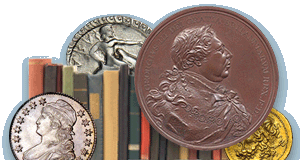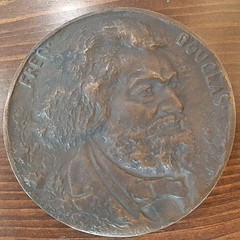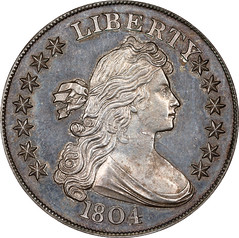
PREV ARTICLE
NEXT ARTICLE
FULL ISSUE
PREV FULL ISSUE
NOTES FROM E-SYLUM READERS: AUGUST 24, 2025
More on that 'Fred. Douglas' Medal "The medal is also missing the final "S" on his last name, correctly spelled "Douglass/"" 
Indeed. Thanks. A former slave, Douglass became a social reformer, abolitionist, orator, writer, and statesman. He was the most important leader of the movement for African-American civil rights in the 19th century. -Editor
To read the earlier E-Sylum article, see:
For more on Frederick Douglass, see:
The Elephant in the Greek and Roman World "In reference to the nicely-illustrated note on elephants on ancient coins in the latest E-Sylum, I recommend an important reference on the overall topic: Scullard, H. H. 1974. The Elephant in the Greek and Roman World. Thames and Hudson (Cornell University Press in the US). "Though the book does not contain a separate chapter on numismatics, there are eight glossy black and white photo-pages of elephants on coins (see attached example). These and the accompanying text demonstrate that Carthaginian armies contained both African- and Asian Elephants. The latter species, of course, was used by the Seleucid kingdoms. Anatomical differences of the two species are evident on various coins, and once enlightened, it is usually easy to interpret most numismatic depictions." Thanks. Also, my friend Gerry Porter of the Western Pennsylvania Numismatic Society published a catalog in 1983 - Elephants in Numismatics and Exonumia from Ancient to Modern Times. -Editor
To read the earlier E-Sylum article, see:
Can Coin Counterfeiters Fool the Experts?
"That is pretty terrifying but I wonder if it can be done and then what about more common yet still rare pieces? "Seems like the kind of stuff that could cost me some sleep." Well, the auction catalog description for the James A. Stack 1804 Dollar has yet to be written and published, so stay tuned on the provenance of this piece. Clues that may have been overlooked before will be reviewed in the new light of this discovery. But your question is valid - will counterfeiters eventually improve their craft to the point where their work is undetectable? My thought on this is that the cat-and-mouse game between counterfeiters and counterfeit detectors is never ending. Both sides continue upping their game to outfox the other, but as soon as one side gains an advantage, the other finds a way to surmount it. What do readers think? -Editor
To read the earlier E-Sylum article, see:
AI in Numismatic Publishing "The September issue of The Numismatist included this notice: "A large percentage of the July 2025 cover story (‘Coins of the Indian Subcontinent,' p. 26) was generated using artificial intelligence (AI) software, a fact the author did not disclose at the time of submission in early 2024. We have since updated our submission guidelines to require full disclosure of any AI-assisted writing. Additionally, since late 2024, our review process includes the use of detection software to help identify AI-generated content. While the ANA recognizes that AI can be a useful research tool, The Numismatist remains committed to upholding the highest standards of original research, authorship, and scholarship. —Editor." "Editors of all numismatic publications will do well to follow the example of the ANA in reviewing their submission and publication standards, as this will no doubt be an ongoing issue. AI is akin to modern medicine – magical when it works, otherwise not so much. The current web is bombarded with AI-generated content, and I tend to quickly "tune out" whenever I detect non-human generated text. This will get harder over time, but for now kudos to the ANA for owning up to the problem and taking corrective actions." Hear, hear! AI is just another tool, not a substitute. -Editor
Wayne Homren, Editor The Numismatic Bibliomania Society is a non-profit organization promoting numismatic literature. See our web site at coinbooks.org. To submit items for publication in The E-Sylum, write to the Editor at this address: whomren@gmail.com To subscribe go to: Subscribe All Rights Reserved. NBS Home Page Contact the NBS webmaster 
|




